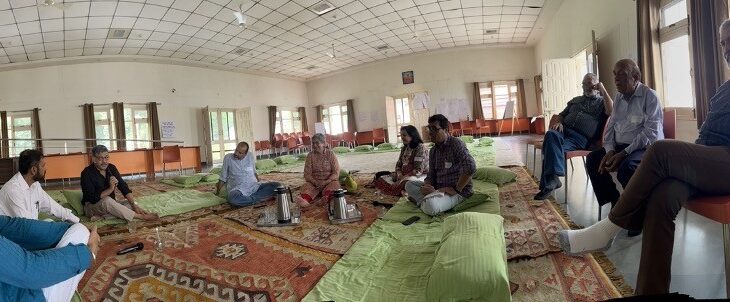The Art and Science of Personal Change: Making Changes that Stay Changed | Prasad Kaipa
IIW Web Team 28 September, 2023
Introduction: The Complexity of Change
In my three-decade-long journey of coaching senior executives and leading workshops on change and habits, I have delved deep into a plethora of change management techniques. My personal journey of change has witnessed some steadfast habits, while others proved elusive. The recent open space conference in Siddhabhari was another cornerstone in this quest.
Here’s an amalgamation of the insights I’ve gathered over the years, reflecting on the complex interplay between various methods to foster lasting change.
Changing oneself is an intricate dance between nature and nurture, science and art, psychology and spirituality. The yearning for change is universal, yet the path is not linear. With a range of methodologies and philosophies to consider, including neurological studies, behavioral theories, Eastern wisdom, and even cultural nuances, how can we navigate the labyrinth of self-improvement? This article aims to weave these threads into a cohesive narrative.
Part 1: Neuroscience and Habit Formation: A Primer
Neurological Underpinnings
Neurological Underpinnings: Research has shown that habit formation involves specific regions of the brain such as the basal ganglia and the prefrontal cortex. It’s not just about willpower; it’s about brain architecture.
Behavioral Insights
Drawing from Katy Milkman’s research on “temptation bundling” and James Clear’s “Atomic Habits,” there’s consensus on the effectiveness of incremental changes. Small steps appear less daunting and are more achievable, forming the basis of what Clear describes as the “compound effect” and can lead to significant transformations.
Part 2: Media Discourse on Habit Formation
CNN on Habit Loops
The cue-routine-reward loop, emphasized by CNN, offers a pragmatic lens to understand and modify habits. Recognizing these loops can pave the way for effective behavioral changes.
Moya Sarner on ‘Habit Stacking’
An article by Moya Sarner in The Guardian discusses “habit stacking,” a technique to cluster positive habits around existing routines. The method offers an elegant way to ease the addition of new habits without cognitive strain associated with decision-making.
Part 3: Indic Wisdom and Personal Transformation
Have you ever noticed that there are two parts of you? One that makes the commitment and the one that delivers on that commitment. That means we operate from different states of consciousness at different times and that state determines our commitment, action and our emotion. One part of us responds well to western approaches that are behavioral or neurological. The other part responds well to insights, intuition and Indic approaches. One of the participants in Siddhabhari mentioned that he stopped smoking all of a sudden when his young son made a request out of concern for his father’s health. He said that he never touched a cigarette ever again.
The Nava Rasas and Emotional Awareness
In Indic philosophy, personal transformation is deeply connected with emotional intelligence. The concept of ‘Nava Rasas’—ranging from anger to tranquility—provides a nuanced framework to understand one’s emotional responses and their impact on behavior. According to Indic Wisdom, emotions do not engender from the brain but arise in the body as energy changes based on anatomical and physiological systems.
Vedanta and Self-Awareness
Vedanta, another pillar of Indic wisdom, focuses on self-awareness as a path to change. Practitioners advocate for mindfulness and a strong sense of ‘swadharma’ (purpose) to bring about personal transformation.
Part 4: Comparative Analysis: Where They Converge and Diverge
Common Ground
Both Eastern and Western approaches value self-awareness. While neuroscience provides tools to decipher our brain’s patterns, Indic wisdom offers a more profound, spiritual sense of understanding oneself.
Points of Divergence
However, they diverge in their prescriptions. Western methodologies are often immediate and actionable, rooted in the empiricism of psychological and neurological research. In contrast, Indic wisdom provides a spiritual and philosophical roadmap for long-term transformation.
Part 5: A Synthesized Path to Change
Case Study: ‘Immunity to Change’
Incorporating Robert Kegan’s “Immunity to Change” model, one can identify hidden commitments that make change difficult. By addressing these subconscious commitments, the path to adopting new habits becomes more accessible.
An Integrated Action Plan ( A detailed integrated plan is given at the end of this article.)
- Begin with neuroscientific methods for immediate habit change.
- Layer these with behavioral techniques like habit stacking.
- Infuse emotional intelligence techniques from Indic wisdom.
- Revisit and revise using the ‘Immunity to Change’ framework.
Conclusion: The Need for an Integrated Approach
While each methodology and philosophy offers valuable insights, an integrated approach provides a nuanced, robust pathway for personal change. It allows for tactical adjustments, offers psychological scaffolding, and provides spiritual or philosophical grounding, thereby attending to the holistic needs of the individual.
By harmonizing these paradigms, the roadmap provides not just tactical shifts but holistic transformations, rooted deeply in both empirical understanding and spiritual grounding. Here’s to a journey of change that is both informed and enlightened.
An Integrated Action Plan
Step 1: Self-Awareness and Diagnosis
Western Approach
- Identify the habit you wish to change or develop, understanding its cue, routine, and reward (Duhigg, 2012).
Indic Wisdom
- Apply mindfulness techniques from Indic traditions like meditation to cultivate self-awareness and clarity about why you want to change a habit and why you keep resisting it at the same time.
Action
- Maintain a journal to track triggers, thoughts, and feelings.
Step 2: Establish New Goals
Western Approach
- Set SMART (Specific, Measurable, Achievable, Relevant, Time-bound) goals.
Indic Wisdom
- Align these goals with your true Sankalpam (deep desire from within)you’re your Dharma (life purpose) for a holistic well-being.
Action
- Use a vision board to visualize your goals and how they align with your broader life aspirations.
Step 3: Develop a Strategy
Western Approach
- Employ behavioral design techniques such as ‘temptation bundling’ to make the new habit more appealing (Milkman, 2021).
Indic Wisdom
- Use Yogic principles or the “Rasas” to pay deeper attention to your emotions and drives that shape your insights and thoughts. Meditate on those insights to gain deeper clarity into yourself.
Action
- Create a strategy map that integrates both these approaches.
Step 4: Implement and Monitor
Western Approach
- Use apps or tools that help you monitor progress (e.g., habit-tracking apps).
Indic Wisdom
- Practice daily reflection and mindfulness to continuously align your head, heart and hands (thoughts, feelings and actions) with your Dharma.
Action
- Dedicate a specific time each day to evaluate your progress. Use both quantitative (data) and qualitative (introspective) methods.
Step 5: Identify and Overcome Immunity to Change
Western Approach
- Confront psychological impediments using cognitive therapy techniques (Kegan & Lahey, 2009).
Indic Wisdom
- Apply ancient Indic techniques such as Vipassana or self-inquiry to unearth deep-rooted mental models that resist change. Gain clarity about your true nature and use those insights as a way to examine your behavior.
Action
- Engage in ‘shadow work,’ a self-reflective exercise that combines both Western and Indic practices to unearth and dismantle hidden barriers.
Step 6: Sustain and Grow
Western Approach
- Scale the new habit by employing positive reinforcement and variable rewards.
Indic Wisdom
- Maintain a state of equanimity to sustain the change and develop resilience, employing regular spiritual or meditative practices.
Action
- As you reach milestones, re-assess and evolve your goals to ensure they continue to align with your overall purpose.
By harmoniously integrating Western science and Indic wisdom, this roadmap offers a balanced and comprehensive pathway to personal transformation. Adapt and customize these steps according to your unique journey, and you’ll be well on your way to meaningful, sustainable change.
Acknowldgments
Thank you Anil Bhai for hosting the session and all the open space participants for either participating in the discussion and for your comments and suggestions on improving it. Thank you. Thank you Raghu for your comments and suggestions as well.
References:
- Clear, James. “Atomic Habits: An Easy & Proven Way to Build Good Habits & Break Bad Ones.”
- Milkman, Katy. “How Can We Help People Make Better Choices.” Behavioral Science & Policy.
- Moya Sarner, “The psychology of ‘habit stacking,'” The Guardian.
- Kegan, Robert. “Immunity to Change: How to Overcome It and Unlock the Potential in Yourself and Your Organization.”
- Milkman, Katy. “How to build habits in 5 steps”https://www.cnn.com/2021/11/29/health/5-steps-habit-builder-wellness/index.html

